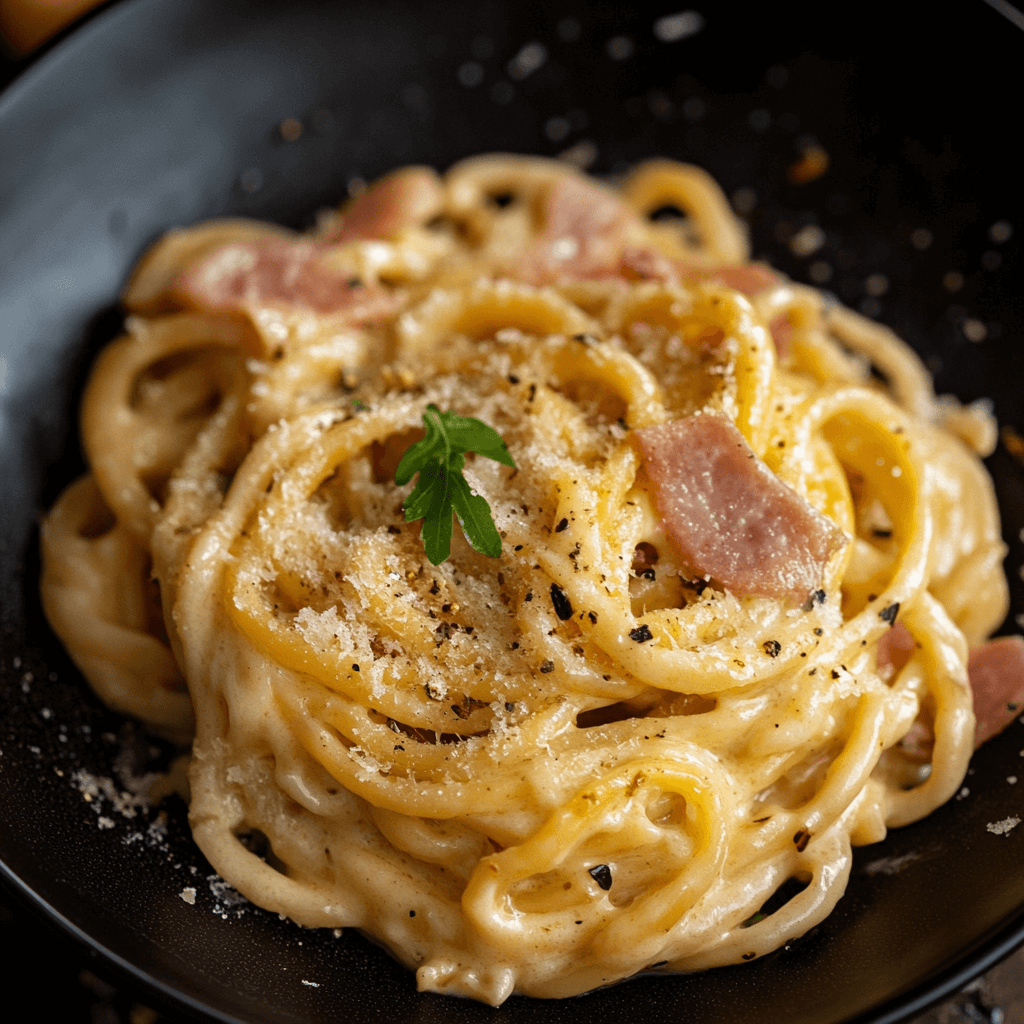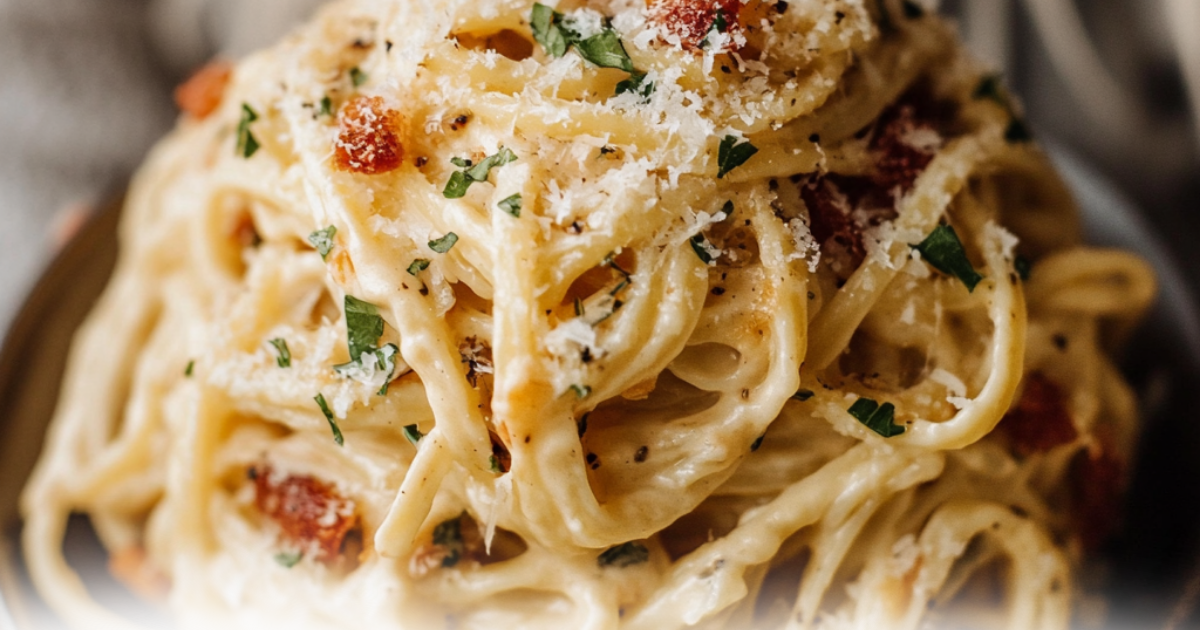Carbonara, a beloved Italian classic, sparks a lively debate about its healthiness. With its creamy sauce, savory chicken, and perfectly cooked pasta, it’s a meal that’s both indulgent and satisfying. But is it good for you? This article unpacks the nutritional aspects of Carbonara, highlights its health benefits, identifies potential risks, and explores ways to make it healthier. Whether you’re a die-hard foodie or a health-conscious eater, you’ll find insights that help answer the burning question: Is Carbonara healthy or unhealthy
Table of contents
Understanding Carbonara’s Nutritional Composition
What Is Carbonara?
Carbonara is a traditional Italian dish that combines spaghetti with a creamy sauce made from eggs, cheese, and meat—typically guanciale. However, in this recipe, chicken is used as a leaner, more heart-friendly protein option. The dish’s richness stems from its simple, wholesome ingredients, making it a staple of comfort food worldwide.

Calorie Content and Macronutrient Breakdown
Let’s dive into the numbers! A standard serving of Carbonara made with chicken contains about 400–500 calories, depending on portion size and ingredient variations. It’s a carb-heavy dish, with pasta contributing most of its energy. The protein from chicken and eggs helps balance the meal, providing around 25–30 grams per serving. However, the fat content, often from cheese, can be moderate to high, accounting for 15–20 grams, including saturated fats.
The Health Benefits of Carbonara Ingredients
Eggs as a Source of Protein and Nutrients
Eggs are the heart of Carbonara’s creamy sauce and a powerhouse of nutrients. They’re packed with high-quality protein, essential for muscle repair and overall health. Additionally, eggs provide vitamins like B12 and D, which support energy production and bone health. Their healthy fats help keep you feeling full, making them a balanced addition to any meal. While they add richness to the dish, moderation is key to ensure they fit into a healthy diet.

The Role of Cheese in Bone Health
Cheese not only enhances the flavor of Carbonara but also contributes calcium, a vital mineral for strong bones and teeth. Parmesan or pecorino, traditional choices in Carbonara, offer a decent dose of protein and phosphorus. These nutrients play a role in energy metabolism and muscle function. However, as cheese can be high in saturated fat and sodium, enjoying it sparingly keeps it from tipping the scales of an unhealthy meal.
Chicken as a Lean Protein Option
Swapping chicken in Carbonara is a smart move. Chicken is a lean source of protein, low in saturated fats compared to cured meats. It’s rich in essential nutrients like niacin, which supports skin and nerve health, and selenium, an antioxidant that boosts immunity. This tweak makes the dish less indulgent and more suitable for those watching their fat and calorie intake. Whether you’re questioning Is carbonara healthy or unhealthy? this adjustment brings a clear benefit.
Health Risks Associated with Carbonara
High Saturated Fat Content
While Carbonara’s creamy goodness is undeniably satisfying, it often comes at the cost of higher saturated fats. These fats, primarily from cheese and egg yolks, can contribute to elevated cholesterol levels if eaten excessively. Over time, a diet rich in saturated fats may increase the risk of heart disease. If you’re pondering Is carbonara healthy or unhealthy? it’s important to recognize this potential downside.
Refined Carbohydrates and Blood Sugar Spikes
The pasta in Carbonara is made from refined wheat, which can cause rapid blood sugar spikes. These simple carbs are quickly digested, leading to a short burst of energy followed by a crash. Overconsumption of refined carbs is linked to weight gain and increased risk of diabetes. Opting for whole-grain pasta instead can mitigate these effects and provide a more balanced source of energy.
Low Fiber Content
Traditional Carbonara lacks fiber, a critical nutrient for digestive health. Since it doesn’t include vegetables or whole grains, the dish might leave you feeling unsatisfied over time. A diet consistently low in fiber can lead to issues like constipation or an unbalanced gut microbiome. To balance the meal, adding fiber-rich ingredients is a simple fix.
Making Carbonara Healthier
Substituting Traditional Ingredients
Transforming Carbonara into a healthier meal starts with ingredient swaps. Replacing heavy cream with Greek yogurt can significantly reduce saturated fats without sacrificing creaminess. Similarly, opting for chicken instead of bacon cuts back on unhealthy fats and sodium. Whole-grain pasta can also be a game-changer, adding fiber and nutrients that are missing from refined pasta.

Incorporating Vegetables
Adding veggies like spinach, peas, or mushrooms can elevate both the nutritional profile and the taste of Carbonara. These additions bring a welcome boost of fiber, vitamins, and antioxidants. Not to mention, they make the dish feel more filling without adding excessive calories. When pondering Is carbonara healthy or unhealthy? incorporating vegetables is a great step toward a more balanced version.
Reducing Saturated Fat
Cutting back on saturated fats is essential for heart health. This can be achieved by using low-fat cheese alternatives or reducing the amount of cheese altogether. Nutritional yeast is a tasty substitute that provides a cheesy flavor with none of the downsides. Another trick? Use fewer egg yolks while keeping the whites to maintain creaminess and protein content.
Comparing Traditional and Healthy Versions
Nutritional Comparison Table
A quick glance at the numbers shows how simple changes make a big difference. A traditional Carbonara might clock in at 600–700 calories, with high saturated fat and minimal fiber. On the other hand, a healthier version with chicken, Greek yogurt, whole-grain pasta, and vegetables could reduce calories to 400–500 while boosting fiber and nutrients.
| Nutrient | Traditional Carbonara | Healthy Carbonara |
|---|---|---|
| Calories | 600–700 | 400–500 |
| Protein (g) | 25–30 | 30–35 |
| Saturated Fat (g) | 15–20 | 7–10 |
| Fiber (g) | 1–2 | 5–7 |
Taste Versus Health
Does a healthier Carbonara taste as good as the original? Surprisingly, yes! Using fresh ingredients and creative substitutions can maintain the dish’s creamy texture and rich flavor. While it might not taste exactly like the classic, it offers a satisfying alternative that supports better health. Ultimately, answering Is carbonara healthy or unhealthy? depends on how you prepare it and how often you indulge.
For more delicious recipes, check out this Carbonara Pizza Recipe.
FAQs About Carbonara and Health
Is Carbonara Good for Weight Loss?
The short answer is: it depends! Carbonara is calorie-dense, especially when prepared traditionally. If you’re trying to lose weight, portion control is key. Choosing a healthier version, like one made with chicken and whole-grain pasta, can fit better into a calorie-conscious diet. Pairing Carbonara with a side of vegetables or a light salad helps balance the meal. So, Is carbonara healthy or unhealthy? For weight loss, it’s all about moderation and smart choices.
Can Carbonara Be Part of a Balanced Diet?
Absolutely! While it might seem indulgent, Carbonara can be part of a balanced diet if eaten occasionally and prepared with care. Opt for lean proteins like chicken, include vegetables, and use whole grains to create a dish that offers more nutrients and fewer empty calories. A balanced diet is about variety and portion control, so enjoy your Carbonara alongside other nutrient-dense foods.
What Are the Healthiest Substitutions for Carbonara?
If you’re looking to lighten up Carbonara, substitutions are your best friend. Swap out heavy cream for Greek yogurt to cut saturated fats. Replace refined pasta with whole-grain versions for added fiber. Using chicken instead of bacon significantly reduces sodium and fat, making the dish better for your heart. Small changes can make a big impact, transforming Carbonara into a healthier option. Wondering Is carbonara healthy or unhealthy? These substitutions make a strong case for the former!
What Are the Healthiest Substitutions for Carbonara?
Looking to lighten up your Carbonara? Substitutions can make all the difference. Replace heavy cream (used in non-traditional variations) with Greek yogurt for a boost of protein and a reduction in saturated fat. Swap refined pasta for whole-grain pasta to increase fiber and aid digestion. Substituting bacon or pancetta with grilled chicken, turkey bacon, or even plant-based options like smoked tempeh can significantly lower fat and sodium content. Adding vegetables such as spinach, peas, or zucchini not only enhances the nutritional profile but also makes the dish more filling. Wondering if Carbonara can be healthy? These changes prove it can be both delicious and nutritious!
Can Carbonara Be Made Dairy-Free?
Yes, it’s possible to make Carbonara dairy-free without sacrificing flavor! Nutritional yeast is a great substitute for cheese, offering a cheesy, umami taste. For the creamy texture, use unsweetened almond milk, oat cream, or cashew cream. Be sure to season generously with black pepper and a hint of smoked paprika to achieve a well-rounded flavor profile.
What’s the Best Way to Reheat Carbonara?
Reheating Carbonara can be tricky because of its egg-based sauce. To prevent the sauce from separating or becoming too thick, reheat it gently on the stovetop over low heat. Add a splash of water, milk, or broth to loosen the sauce as it warms. Avoid using a microwave if possible, as it can overcook the eggs and alter the texture. Stirring constantly while reheating ensures the sauce stays smooth and creamy.


1 thought on “Is Carbonara Healthy or Unhealthy?”